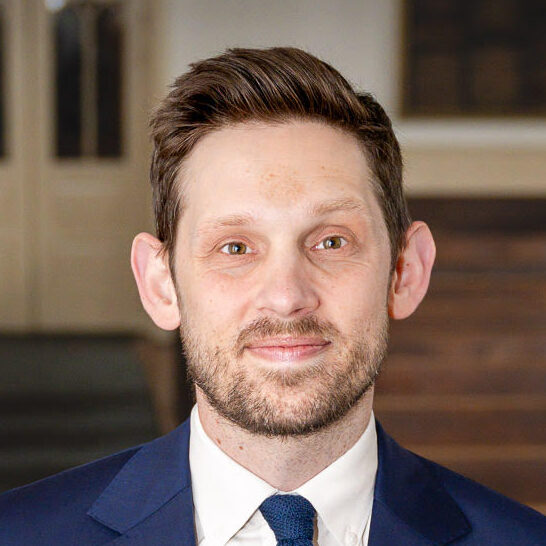Divine Mercy
Of all the rabbinic teachings I have encountered, one of my favorites is also one of the most personally impactful. The teaching is based on a text from the Book of Second Isaiah 56:1, 7. Isaiah is preaching to the inhabitants of Jerusalem, probably sometime after a wave of Israelites has returned from exile in Babylonia to Jerusalem. They’ve returned, but all is not restored. There is still some brokenness inside them, and there is also brokenness in the land to which they’ve returned. Jew and non-Jew alike are living together in the broken ruins of Jerusalem.
Isaiah, as a prophet, channels the voice of God: “Thus said Adonai,” Isaiah says. “Observe what is right, and do what is just. I will bring those who do this to My sacred mount, and I will bring about joy for them in a house of My prayer.”
On one level, this sounds like your standard, prophetic verse, proclaiming a form of salvation if we would but follow God’s exhortations to pursue justice. But according to the rabbis of the Talmud, there is actually something foundationally important in this verse. Something jumps out to them about this verse when God says, “Beit Tefilati/House of My prayer.” What is so important? The Talmud tells us:
Rabbi Yoḥanan said in the name of Rabbi Yose, that “The verse does not say the house of their prayer,” the peoples’ prayer, “but rather, Beit Tefilati, ‘the house of My prayer.’” From this, we learn that the Holy One, Blessed be He,” prays.
God prays, too? Why does God need to pray? Isn’t God omnipotent, all powerful; or omniscient, all knowing? To whom does God pray? What does God pray for? What could God possibly need?
The Talmud ventures an answer to this last question: “Rav Zutra bar Tovia said that Rav said: ‘God’s prayer is: “May it be My will that My mercy will overcome My anger.’” God’s prayer, the rabbis teach, is that in God’s own internal struggle between anger and compassion, the compassion wins out.
I first encountered this teaching as a young man when I was reading through a eulogy of my father, by one of his best friends and classmates, Rabbi Michael Cohen. It has been foundational to my understanding of God ever since. This is so for a number of reasons.
All people, myself included, make bad choices in life, sometimes a series of them. I was someone who went through periods of life racked with shame and guilt. To have it suggested to me in a tradition that I hold dear, from the words of someone I revered, that above all else in the universe, God cherishes rakhamim, compassion, and that I, too, may have been worthy of that compassion, was truly life-altering.
In the High Holy Day makhzor, we say, “God, you wait until the day of one’s death, and if that person returns, You, God, immediately embrace them.” While human beings don’t need to forgive you for your mistakes, God does. God embraces you on your return, cherishing compassion above all other attributes.
God prays: “May it be My will that My mercy will overcome My anger.”
Humanizing God
But the paramount nature of mercy is not the only reason this text spoke to me so profoundly. At the risk of offering something heretical, or at the very least paradoxical, this text in an important way humanizes God, in a manner that, I believe, can have a profound effect on our relationship to Divinity, which, for me, is the source, the root, from which the rest of our life flows.
We often cite a corollary to the point about portraying God’s humanity from the first chapter of the first book of the Torah, Bereishit, Genesis, which says, ”God created humankind in God’s own image.” We are each created in the image of the Divine, in the image of God, all of us.
My suggestion is that the reverse is true: Echoes of us, whispers of us, reverberations of us, are present in God. Of course, there is a danger in projecting our ego onto God, in mistaking the lamp for the light, but when we consider our complexity, our pain, our aching, our struggles, our ambivalence, our joy, our pathos, our feelings of love and connection with those around us, our yearning for what is good and true, do we imagine these experiences were manufactured out of thin air? Do we not imagine a God who knows these experiences, too, as well as, if not better than, we do?
If the whole universe comes from God, which I recognize is not something all of us believe, but if it does, do we not imagine the whole range of the human experience, and more, comes from God, is in God, too? I imagine a bridge, a continuum, from humanity to God and back, a bridge built of empathy, pathos and feeling.
We struggle to control our anger. According to this tradition, so does God.
We long for the connection, the reassurance, the solace found in prayer. So does God.
We reach out for connection to the Source of the Universe. So does God, even if, for us and for God, it is to be found somewhere deep within us.
I want to be clear — Judaism doesn’t speak with one voice when it comes to theology, to an understanding of God. If anything, Judaism is not marked not by dogmas, by singular beliefs from which no one can deviate for fear of being not Jewish enough. Rather, it is marked by diversity of belief. The Talmud offers that Rabbi so and so says X; Rabbi such and such says Y, with no resolution of who is right. It preserves the diversity of views — an ingenious religious move that helps us hold space for doubt, hold space for the recognition that we each will have different depictions of God that move us.
The medieval Jewish philosopher the Rambam, Maimonides, teaches that the best way to connect with God is to try and get as far away from human associations as possible. Even as seemingly uncontroversial a description as God is wise, Maimonides suggests, has us conjure up a wise human being — only more so — and that does a disservice to understanding God, Maimonides says. It misleads us, because God is on such a different plane, so beyond the human descriptor of “wise,” that to use that descriptor simply leads us astray.
There can be power and spirituality in recognizing the limits of language, and in recognizing that Godliness transcends all language. Still, Jewish tradition also has it that God spoke and called the world into being. God said, “Let there be light,” and there was light. There is power in speech and what it is able to evoke for us — the worlds it is able to create in our imaginations and in our reality. Here are a couple more midrashim (tales), woven for us by our rabbinic ancestors in their efforts to articulate their understanding of God’s humanity, and to connect to it.
God’s Many Faces
First, an overarching teaching from Pesikta Rabbati, a medieval text that cites Rabbi Levi for the following teaching:
At Mount Sinai, God appeared to the people with many faces: a threatening face, a severe face, an angry face, a joyous face, a laughing face and a friendly face. To some, God appeared standing, to others seated, to some as a young person and to others as an old person.
The implication is that there are a number of different pathways for encountering God, depending on who we are and where we are in life. There are multiple pathways into the Divine, and opening ourselves up to different ways of encountering God doesn’t change God’s underlying essence. It merely allows us to connect, to plug in, to draw strength and inspiration from the Divine in the ways we need to, in order to carry out our tasks in the world.
God Laughs
Another text, this time from the Talmud (Avodah Zarah 3b). It opens up with a debate about whether or not God mesakhek: (makes sport, rejoices, laughs). Does God laugh? One rabbi, Rabbi Yitzchak, whose name, paradoxically, comes from a similar word meaning “laughter,” says that God does not have fun, does not laugh, at least not until the day before the Messiah comes and inaugurates an age of redemption. On that day, Rabbi Yitzchak says, God will laugh. Until then, no.
But because this is the Talmud, that is not the only voice. Rav Yehudah says that Rav says that not only does God laugh; God laughs, has fun, every day. To demonstrate this, he proceeds to go through God’s entire day, each day. There are 12 hours in a day, he says. (They divided a 24-hour day into 12 daytime hours and twelve nighttime hours.) “During the first three hours, the Blessed Holy One sits and studies Torah.”
There is also something profound about the implication that God is not done learning, about the implication that God has the humility to say, not once but every day, I need to go deeper, need to stretch the limits of My capacity to grow, to evolve, to learn. That’s how central learning is to God’s day-to-day activities and, by implication, how we might imagine ours. According to the Talmud, that’s the first three hours of God’s day
“During the second three hours, God sits and renders judgment over the entire world.” In doing so, God sees, the Talmud says, that the proper sentence, according to this rabbi, is kelaya, destruction, and yet, the rabbi says, God spends part of that second three hours moving from the throne of judgment to the throne of mercy, part of the central imagery of Yom Kippur. Yes, God sees that, according to the strict letter of the law, we, the world, are liable. But God spends God’s considerable energies and time moving from the throne of judgment to the throne of compassion, understanding that even if a person, even if the world, is technically guilty, that doesn’t necessarily mean that the right result is to rain down on us with strict judgment. A bridge of compassion is the better course. Once again, we have God wrestling with these twin instincts of judgment and mercy, with mercy, compassion and understanding prevailing.
“For the third set of three hours, God provides nourishment for the entire world” — from the tiniest bug, it says, to the largest ox. Like some cosmic agricultural steward going about their daily chores, God puts forth nourishment into the earth. Though perhaps it is up to us to ensure it gets to everyone who needs it.
And for the fourth and final set of three hours “God makes sport with Leviathan.” The Hebrew Bible makes passing reference to a giant ocean creature, and the rabbi cites this to strengthen his case that God has fun and laughs. Right there in Psalm 104, it says לְשַֽׂחֶק־בּֽוֹ “There is Leviathan, whom you formed to play with.” Therefore, the rabbi submits, God does indeed laugh not just on the one day, but every day, and not just with Leviathan, but with all of God’s creation.
The rabbis then continue opening up portals, stretching our imagination for how we might conceive of and relate to the Blessed Holy One. It’s true, Rav Akha, retorts. For a while, God did laugh every day, but, he says, “From the day that the Temple was destroyed, there is no more laughter for the Blessed Holy One.”
I imagine a bridge, a continuum, from humanity to God and back — a bridge built of empathy, pathos and feeling.
On one level, the destruction of the Temple is an epochal moment in the life of the Jewish people and their relationship to God. It severed the traditional lines of communication — sacrificial offerings — between God and God’s people, dispersing them into exile, inaugurating a stage of history in which brokenness reigned. That, in and of itself, would be enough to upend God’s laughter. But it actually goes further than that. The Temple’s destruction symbolizes the general state of the world as we know it, in contrast to its Edenic origins and in contrast to its redeemed future. It symbolizes the general state of the world’s brokenness, and that is a condition in which God no longer laughs, this rabbi argues, offering a few scriptural verses as proof.
OK, the rabbis respond, if God is no longer spending the fourth quarter of God’s day playing sport and laughing with Leviathan, how does God spend that block of time? “God sits and teaches little ones.” God sits and teaches Torah to schoolchildren, citing a verse from Isaiah as proof.
Little ones? The famous commentator Rashi asks. “To whom does this refer?” Little ones in school today? “No,” Rashi answers. “The ones who died when they were young.” God, he concludes, is spending God’s final three hours each day teaching Torah to young children who left this world too soon.
God Weeps
We grow up in a world with pretty central imagery for who and what God is. Consider the opening part of every traditional blessing: Barukh atah adonai eloheinu melekh ha’olam, “Blessed are you, Lord, our God, Sovereign of the universe.” For many people, the imagery of lord and king is hardly inviting. Clearly, this is not all that our tradition has to offer. The richness of our rabbinic tradition offers a tapestry of experiences of the Divine that go far deeper than the classic sovereign, depicting God’s pathos, God’s heartbreak, God’s yearning, God’s struggle.
When the prophet Jeremiah is concerned about the peoples’ deviation from the covenant, from what is good and true, he says to them: “If you will not give heed, my inmost self will weep, due to your arrogance” (Jeremiah 13:17). These words come from the prophet Jeremiah, but the rabbis imagine that it is really God saying this. It is God who says God’s inmost self weeps, heartbroken by our deviation from what is good and true — by the burning of the planet, the harassment of the immigrant, the neglect of the widow and orphan, by poverty, hunger and war.
My inmost Self weeps, the rabbis imagine God saying.
“But is there really weeping by the Holy One, Blessed be He?” the Talmud asks. Didn’t a revered rabbi, Rav Pappa teach: “There is no sadness from the Holy One, Blessed be He, as it is stated in the book of Chronicles (I Chronicles 16:27), ‘Honor and majesty are before God; strength and gladness are in God’s place’ ”?
In this case, the Talmud resolves the dispute: This statement, that God does not cry, is referring to the outer chambers; the statement that God cries, is referring to the innermost chambers, where God can cry in secret.
God is ambivalent about how transparent to be with God’s heartbreak.
How can we square these depictions of God — pained by the failure of the people to follow through on their commitments; heartbroken over the destruction of the Temple; struggling between God’s instincts towards anger on the one hand and compassion on the other? How can we square these depictions of God with the classic depiction of God as the savior who splits the sea, hurling the Egyptians into it, scolding the angels not to sing upon their demise. How do we square these alternative, seemingly contradictory, depictions of God?
There are, I think, at least a couple of ways to answer this.
First, remember that God appeared to the people at Mount Sinai with many faces: a threatening face, a severe face, an angry face, a joyous face, a laughing face and a friendly face. That is, God is present in all of this: in our strength and in our surrender, in our courage and in our fear, in our heartbreak and our healing, in our anger and in our compassion. At different moments, we need different experiences of God: U’ve-shofar gadol yitaka, ve-kol demama dakah yishama — “The great shofar will be sounded and the still small voice will be heard.” Our tradition seeks to provide us with a multitude of pathways into the Divine. It’s up to us to play with them, like colors on a palette that we mix and arrange with our brush, sweeping this way and that, until we find the richness and texture that moves us, all of these depictions ultimately flowing from the same underlying Source, Jewish tradition says.
So on one level these different depictions are different pathways to God.
But another, perhaps more pointed way to ask the question of how we square these different depictions is to ask specifically: How do we square the understanding of a God who intervenes in history, of a God who is omnipotent, the source from which all the world flows, with a God heartbroken over the evils of the world? Put most pointedly, if God is so heartbroken, why doesn’t God do something about it?
Jews have been asking this question since the biblical book of Job, if not before. God answered Job resoundingly (Job 38:4), “Where were you when I laid the earth’s foundations?” The universe is vast and mysterious, God seems to be suggesting. There’s a lot we don’t fully grasp.
The richness of our rabbinic tradition offers a tapestry of experiences of the Divine that go far deeper than the classic sovereign, depicting God’s pathos, God’s heartbreak, God’s yearning, God’s struggle.
God’s Heartbreak
Second, when it comes to God’s relationship to the heartbreak in the world, the question might be, “How can we help facilitate God’s presence here?” “Our task,” Rabbi Abraham Joshua Heschel says, “is to open our souls to God, to let God again enter our deeds.”
Judaism teaches that there is a partnership between God and man. We can imagine the synergy between God’s presence and humanity’s action. We pray to find the harmony that weaves them together. We pray to draw inspiration from the source of life, fueling us in our actions as we reveal God’s presence here on earth.
For me, imagining a God struggling, praying for the strength to do what is right, gives me strength as I try to do the same. Paradoxically, this depiction of God’s vulnerability opens me up to feel strengthened by God.







